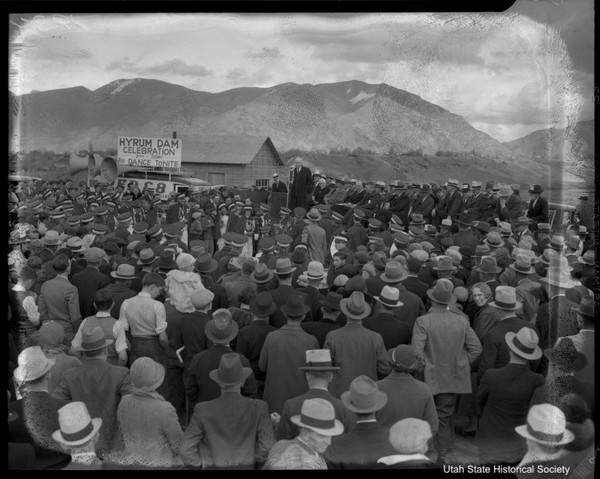Dublin Core
Title
Description
Flowing through an area of Hyrum called Paradise Hollow in southern Cache Valley, the Little Bear River not only provided essential irrigation water to early farmers, but its hydraulic power also operated a sawmill, electric light plant, cheese factory, and slaughterhouse by the early twentieth century. Such facilities made Hyrum one of the most modern towns in Cache Valley. In 1918, however, water shortages prompted residents to work with the federal government to sacrifice the industrial and agricultural opportunities of Paradise Hollow to construct a dam and fill the area with the waters of the Little Bear. Although originally built for the simple purpose of storing water, the Hyrum Dam -- and the reservoir it created -- grew to be a major part of community life.
Residents formed the South Cache Water Users Association and sold enough water shares by 1934 to build the Hyrum Dam. A joint effort between the Association, the federal Works Progress Administration, and U.S. Bureau of Reclamation, the project provided much needed jobs for residents still suffering the effects of the Great Depression. Its construction required 43,000 dump-truck-loads of cement, with the completed dam stretching 540 feet long, 600 feet wide, and 100 feet high -- that’s about two football fields long and two across!
Over time, residents viewed the dam and reservoir less as an agricultural project, and more as a recreational asset to the community. The flow of the water created a natural beach for launching boats or taking a dip. Local residents worked with the City, Chamber of Commerce, and Lions Club to flatten the beach and get rid of sudden drop-offs to make the water safer for swimming, fishing, boating, ice skating, and lakeside picnics. Hyrum City also held local celebrations at the dam, including professional boat races, water carnivals, and 4th-of-July festivities. People from all over Cache Valley came to watch the fireworks flash and sparkle over the water.
Beyond its practical purpose, the Hyrum Dam became an essential part of the community and was protected as a State Park in 1959. Like many Utah reservoirs, it shows how a utilitarian project can become a recreation hot-spot and an important place for community gathering.
Creator
Source
_______________
See Hyrum City Museum, exhibition file for The Hyrum Dam: Building a Dam, Building a Community curated by Samuel Parr, 2013; Eldon J. Nielsen Interview, 5 February 2014 at the Hyrum City Museum; "All Cache Valley to Celebrate at Hyrum," South Cache Courier, 5 June 1936, Hyrum City Museum Archives, South Cache Courier Collection, Box 6; Series 30114 “Northern Region Hyrum State Park photographs,” Department of Natural Resources, Division of Parks and Recreation; Series 23437 “Northern Region Hyrum State Park administrative records,” Department of Natural Resources, Division of Parks and Recreation.

